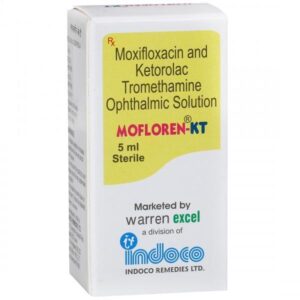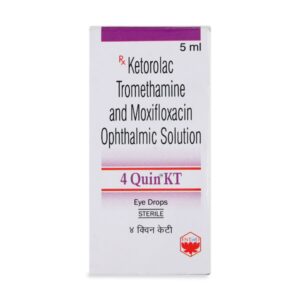KETOROLAC + MOXIFLOXACIN
Ketorolac: Ketorolac is a nonsteroidal anti-inflammatory drug (NSAID) used primarily for its analgesic (pain-relieving) effects. It is commonly used for the short-term treatment of moderate to severe pain, such as postoperative pain or pain due to kidney stones.
Its mechanism of action involves inhibiting the production of prostaglandins, which are chemicals produced by the body that contribute to inflammation and pain. By blocking the enzyme cyclooxygenase (COX), Ketorolac reduces the synthesis of prostaglandins.
The dosage of Ketorolac can vary depending on the specific condition being treated and patient factors such as age and weight. It is typically available as an oral tablet or as an injection. For the oral tablets, the recommended initial dose for adults is 10 mg every 4-6 hours, not to exceed 40 mg in a 24-hour period. For the injection, the recommended adult dose is 15 to 60 mg as a single dose or in divided doses, with a maximum total daily dose of 120 mg.
Like other NSAIDs, Ketorolac can potentially cause a range of side effects. Common side effects include gastrointestinal issues such as nausea, vomiting, and stomach pain. It may also cause dizziness, drowsiness, headache, and fluid retention. In some cases, serious side effects can occur, including gastrointestinal bleeding, kidney problems, and allergic reactions. Long-term use of Ketorolac or taking it at high doses can increase the risk of these adverse effects.
It is important to use Ketorolac as directed by a healthcare professional and not exceed the recommended dose or duration of treatment. Clinical monitoring of kidney function and blood counts might be recommended during therapy. As with any medication, it is crucial to discuss potential risks and benefits with a healthcare provider before starting Ketorolac.
Moxifloxacin: Moxifloxacin is an antibiotic medication used to treat a variety of infections caused by bacteria. It belongs to a class of drugs known as fluoroquinolones.
Its mechanism of action involves inhibiting the activity of enzymes called DNA gyrase and topoisomerase IV, which are essential for DNA replication in bacteria. By disrupting these enzymes, Moxifloxacin prevents bacteria from multiplying and thus helps to eliminate the infection.
The dose of Moxifloxacin depends on the specific infection being treated. Generally, the recommended oral dose for adults is 400 mg once daily, while for intravenous administration, it is 400 mg once daily as well. It is important to follow the dosage instructions prescribed by your healthcare provider.
As with any medication, Moxifloxacin may cause side effects. Common side effects include nausea, diarrhea, headache, dizziness, and insomnia. It may also cause an increased risk of tendonitis and tendon rupture, so it is important to report any tendon pain or swelling immediately. Additionally, Moxifloxacin can cause photosensitivity, leading to an increased sensitivity to sunlight. It is recommended to avoid excessive sun exposure or use proper sun protection while taking this medication.
Serious side effects are rare but can include a severe allergic reaction, liver problems, and a potentially life-threatening irregular heart rhythm. If you experience any severe or persistent side effects, seek medical attention immediately.
It is important to note that Moxifloxacin should only be used to treat bacterial infections and is not effective against viral infections such as the common cold or flu. Additionally, this medication should be used with caution in certain populations, such as those with a history of tendon disorders, epilepsy, or myasthenia gravis. It is always best to consult with a healthcare professional for personalized advice and guidance regarding the use of Moxifloxacin.



